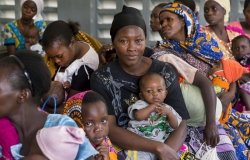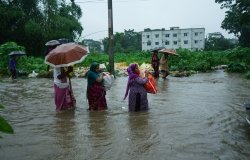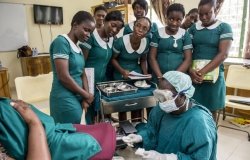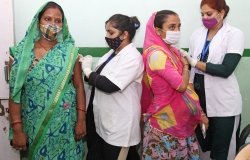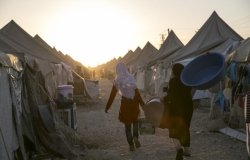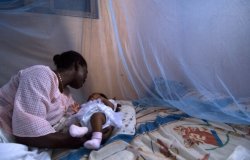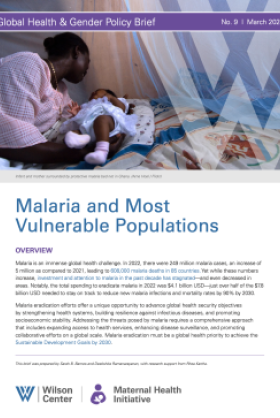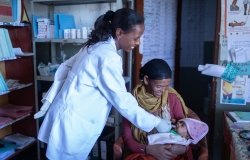Measuring Maternal Health in a Post-MDG World
As the international development community looks back on the Millennium Development Goals and ponders what remains to be done under the proposed Sustainable Development Goals, the maternal health field has some reflecting to do, said Dr. Ana Langer, professor and director of Harvard’s Maternal Health Task Force at the Wilson Center on December 1.
Overview
As the international development community looks back on the Millennium Development Goals and ponders what remains to be done under the proposed Sustainable Development Goals, the maternal health field has some reflecting to do, said Dr. Ana Langer, professor and director of Harvard’s Maternal Health Task Force at the Wilson Center on December 1.
“We used to have, or still have, one goal for maternal health…and we now face some challenging global policy situations,” Langer said. “The challenges are huge, in terms of indicators, sources of info, the tools we use, the way we frame the question.”
Contact or Content?
Recent studies have been trying to better understand what maternal health indicators actually measure and how well, said Dr. Stephen Hodgins, a senior technical advisor with Save the Children.
There is concern, for example, about how the presence of a skilled birth attendant, a common indicator of professional care, is used. Surveys typically count the presence (“contact”) of a skilled birth attendant rather than the quality of care they provide (“content”). While a skilled birth attendant is certainly preferable to an unskilled attendant, it can be unclear how helpful they actually are in preventing complications for mother and child. In one study conducted in Bangladesh, Hodgins and his team predicted a rapid increase in the presence of skilled birth attendants would result in rapid decreases in neonatal mortality rates. Instead, they found mortality rates actually decreased at a slower rate when a skilled birth attendant was present.
Results like this are causing experts to re-evaluate what kind of indicators they use as they move into the next era of development goals. “The contact does matter as an important process dimension, but not as an overall measure of program performance,” Hodgins said. “So I would suggest that rather than tracking [skilled birth attendants] that we track institutional delivery rating.”
Dr. Jim Ricca, a senior advisor to USAID’s Maternal and Child Survival Program, had similar concerns about common indicators, noting that researchers often rely what’s easiest to measure. “The fact that it’s easy to measure doesn’t mean it’s the right thing to measure,” he said. The “content” of an interaction with a health system may be a better indicator than the frequency of interactions.
At the same time, the best ways to measure quality can be hard to define and agree on. “People say we need to measure the quality of care, which certainly we do,” Ricca said. “But a lot of times that discussion gets bogged down into very detailed sorts of quality methodologies which probably don’t belong in a conversation of what we track on an ongoing basis.”
How Accurate Is the Data?
Poor data and data from varied, hard-to-compare sources can also complicate efforts to understand the maternal health environment, said Ann Blanc of the Population Council. She and colleague Charlotte Warren recently conducted a study with the support of the Maternal Health Task Force to try to understand how well certain indicators are reported.
Speaking to women who delivered in facilities in Kenya and Mexico, researchers asked women in face-to-face interviews about the type of care they received prior to, during, and after birth. These answers were compared to documentation by trained third-party observers in the facilities. In comparing how women remembered things versus what the observers saw, they hoped to identify “valid indicators,” which were reported accurately and give a meaningful reflection of care.
Questions involving the administration of medicine or drugs were among the most inaccurately reported and considered invalid, as most women could not identify the type of medicine that was asked about or whether or not they had received it during their time in the facility. The questions that were most accurately answered included what type of facility the mother gave birth in and whether or not the baby had skin-to-skin contact with the mother immediately after birth.
The results of the study confirmed some of the most commonly used indicators, such as the presence of a skilled birth attendant, are often validly reported, but that validity can depend on the context and wording of questions asked to patients, which has important implications for measuring quality of care.
Setting Expectations
Maternal health needs to be part of the Sustainable Development Goals and these discussions around how to measure where we are and where we need to go are crucial, said Tom Pollum, director of research at the DHS Program and a member of the UN Maternal Mortality Estimation Interagency Group.
Pollum and other experts have been meeting since April 2013 to craft new targets for the post-2015 agenda as well as discuss strategies to achieve those targets. Targets are important not only because they require some specificity about what to accomplish and a timeframe, but because they mobilize policymakers and donors.
The most prominent indicator for measuring maternal health has been maternal mortality ratio – the number of deaths per 100,000 live births. Between 1990 and 2013, the world’s maternal mortality ratio dropped 45 percent, from 380 to 210 per 100,000 live births. By 2030, said Pollum, the new target is to bring that number down to 70. A secondary target will be to ensure countries with the highest maternal mortality ratios do not exceed 140, or twice the global level. In order to meet these goals, the global maternal mortality rate will need to be reduced at a rate of 5.5 percent a year.
These are ambitious goals, Pollum said, as the countries with the highest maternal mortality rates must reduce their rates fastest but are often the most difficult places to work. In addition, all countries, regardless of development status, must actively focus on their most vulnerable subpopulations – those remaining areas where services have not reached.
Maternal mortality ratio remains a central focus because it is shaped by many of the other indicators like quality of care, access to care, and the presence of skilled birth attendants, Pollum said. But the role of other indicators in the SDGs is still up for debate. Langer pointed out that traditional birth attendants are still staples in many places, especially in the poorest areas, despite the fact their presence and effect are rarely noted. She suggested this should change. “We should analyze very seriously what could be done to strengthen [traditional birth attendants’] abilities or how to make them productive members of the health system, maybe for some limited roles, but for some very important roles as well,” she said.
Blanc added that there are other macro-level trends that deserve attention, such as the fact that neonatal and maternal mortality rates don’t always decline in tandem.
But all the panelists agreed that quality of care deserves a bigger conversation and more study. “To our knowledge [our research is] the only validation studies of maternal health indicators that have been done,” Blanc said. “We sort of couldn’t believe that was true.”
Event Resources:
Written by Linnea Bennett, edited by Schuyler Null.
Speakers

Sandeep Bathala
Ann Blanc, PhD
Dr. Stephen Hodgins
Dr. Ana Langer
Tom Pullum, PhD
Dr. Jim Ricca
Charlotte Warren, PhD
Hosted By

Maternal Health Initiative
The Wilson Center’s Maternal Health Initiative (MHI) is dedicated to improving the lives of women, adolescents, and children around the world. MHI convenes experts from around the world to discuss solutions to end preventable maternal and newborn deaths and to navigate gender-based global health issues and their links to foreign policy. MHI explores a wide range of policy-related topics, including gender equity, global health, health care workforce and systems, caregiving, gender-based violence, workforce participation, girls’ education, and sexual and reproductive health and rights. MHI is globally focused with additional attention to women and girls living in humanitarian settings. Read more

Global Risk and Resilience Program
The Global Risk and Resilience Program (GRRP) seeks to support the development of inclusive, resilient networks in local communities facing global change. By providing a platform for sharing lessons, mapping knowledge, and linking people and ideas, GRRP and its affiliated programs empower policymakers, practitioners, and community members to participate in the global dialogue on sustainability and resilience. Empowered communities are better able to develop flexible, diverse, and equitable networks of resilience that can improve their health, preserve their natural resources, and build peace between people in a changing world. Read more
Thank you for your interest in this event. Please send any feedback or questions to our Events staff.
